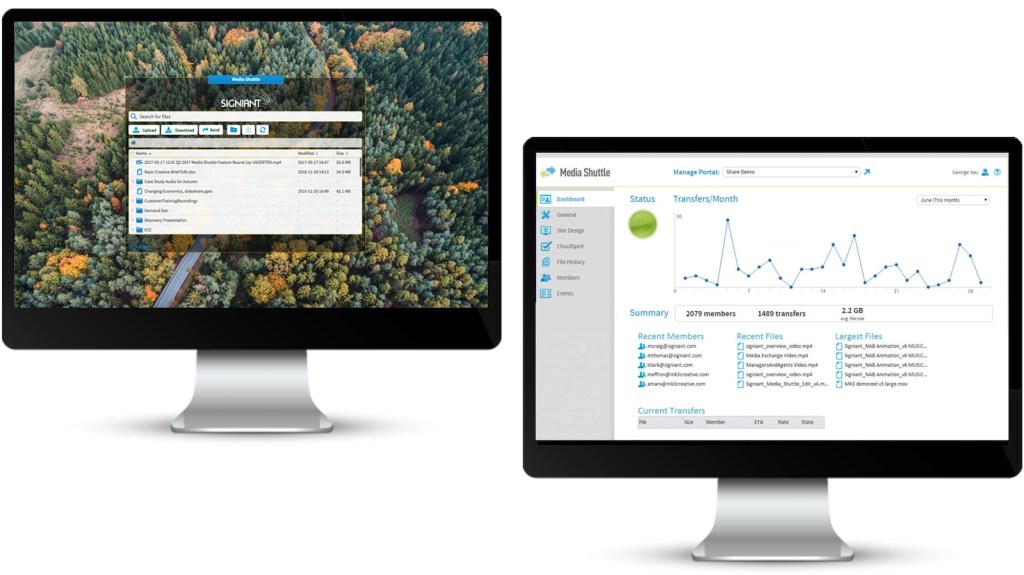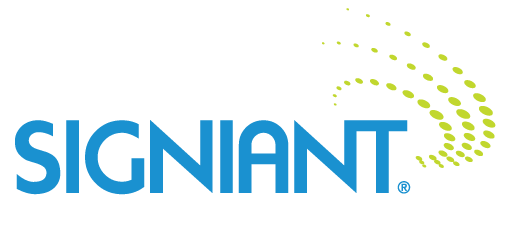Drones are capable of collecting massive amounts of data, but for anyone who has spent hours, or even days, transferring that data, that capability can feel more like a roadblock than the game changer it is meant to be. Not only can long data transfer times be time consuming, it can directly affect your bottom line and whether you can make a business case.
 Moreover, the methods that are often used lack the level of security needed to ensure data integrity and protection, especially when drones collect data on critical assets. This is why Signiant, a leading company specializing in file acceleration software, has developed a fast and secure way to transfer data through their cloud-native SaaS solution, Media Shuttle. In an exclusive interview, we spoke with Jon Finegold, Chief Marketing Officer at Signiant, to find out more about Signiant, how it can enable drone companies to scale and offer the value that large amounts of high-quality data can bring to many industries, how data transfers can be made securely and reliably, and more.
Moreover, the methods that are often used lack the level of security needed to ensure data integrity and protection, especially when drones collect data on critical assets. This is why Signiant, a leading company specializing in file acceleration software, has developed a fast and secure way to transfer data through their cloud-native SaaS solution, Media Shuttle. In an exclusive interview, we spoke with Jon Finegold, Chief Marketing Officer at Signiant, to find out more about Signiant, how it can enable drone companies to scale and offer the value that large amounts of high-quality data can bring to many industries, how data transfers can be made securely and reliably, and more.
Danielle Gagne: How did Signiant first get started?
Jon Finegold: Signiant’s success as a company emerged in two waves: the first began in the mid 2000s as the media industry transitioned to file-based workflows and Signiant’s patented file acceleration technology became indispensable to most of the world’s top media companies who needed a way to move massive digital files around the world.
The second wave coincided with the cloud revolution and Signiant’s development of SaaS solutions that have since been adopted by companies of all sizes and from many sectors. Signiant was an early pioneer of cloud-native SaaS solutions for high-speed large file transfers, releasing Media Shuttle in 2012. Media Shuttle brought the power of Signiant technology — the ability to quickly and securely transfer any size file, anywhere in the world — to any size business. Today Media Shuttle is used by more than 25,000 companies and has moved petabytes of high value content across the world.
What are some of the biggest challenges facing the industry that your company seeks to solve?
In many industries, data is the most valuable asset. In order to capture the value of that data, it needs to move securely and efficiently between people, between systems and to and from the cloud. Signiant’s software makes it easy to accomplish that – to move any size data set, anywhere in the world with speed, reliability and security.
Why do we need to start thinking about how we transfer and manage data?
Across data-intensive industries, files keep getting bigger, workflows are becoming more global and more complex and security challenges continue to grow. With those dynamics, standard tools from shipping hard drives to FTP and consumer file-sharing tools like Dropbox just don’t cut it. Fortunately, there are modern intelligent file transfer tools that were designed to meet the modern challenges faced by data-intensive industries. Signiant Media Shuttle offers patented file acceleration technology that can move any size file over any internet connection with speed, reliability and enterprise-grade security.
How does large file transfer software work?
Standard TCP is what provides a reliable stream of data from one point to another over the internet. For the large majority of internet traffic, TCP works really well. But for large files and data sets — especially larger files sent over distance — TCP breaks down.
One fundamental problem with traditional TCP is that it uses a relatively unsophisticated sliding window mechanism, only sending a certain amount of data over the network before it expects that data to be acknowledged as received on the other end. As TCP receives acknowledgements, it advances its window and sends more data. If the data doesn’t get through or an acknowledgement is lost, TCP will time out and retransmit from the last acknowledged point in the data stream.
There are a number of problems with this, such as retransmitting data that may have already been received, or long stalls in data sent while waiting on acknowledgements. Modern versions of TCP have addressed these challenges in two ways, scalable window size and selective acknowledgements.
Scalable window size allows the amount of data in flight to be greater than the original 64KB or 32KB supported by the protocol. This means that a system administrator can configure TCP to have a bigger window size and most systems today do so by default.
Selective acknowledgement allows the endpoint to verify which pieces of the transmission have been received so that any section that is missing — even one in the middle of the data set — can be retransmitted rather than the entire data set.
Signiant uses a mechanism similar to a scalable window and selective acknowledgement, but we’ve implemented them in an improved way. Using a dynamically adaptive window size, Signiant solutions properly size the window to the bandwidth delay of the network in order to keep an optimal amount of data in flight at all times.
Signiant is also constantly measuring effective throughput, network latency and loss, and building a history. By maintaining a history, we can see how all of these factors are changing over time. And, by analyzing the frequency of changes, we can locate network congestion. This affords us far more efficiency than congestion control algorithms that react to simple point-in-time packet loss, which is a problem with even modern TCP.
What are the key differentiators of your data solution compared to other solutions being used out there such as FTP, cloud-based solutions, hard drives, and so on?
Signiant software is unique in a number of ways. Our patented acceleration technology can move any size file over any IP network up to 100 times faster than traditional methods. Checkpoint Restart ensures reliability by automatically restarting any interrupted transfers. Additionally, in a world where many types of storage are in play, both on-premises or in the cloud, Signiant’s commitment to storage independence makes it easy to move data into and out of any type of storage, anywhere in the world. Finally, our leadership in cloud-native SaaS has made it very easy to deploy, manage and use our advanced technology and allows our products to scale up and down to meet the needs of any sized business.
One of the biggest determinants on whether a business ultimately adopts drone technology, or any technology that collects large amounts of data, is determining whether it is more efficient and helpful than what they are doing currently. One of the biggest bottlenecks is data transfer. How does your solution help build that use case?
Each of Signiant’s four products leverages our core acceleration technology, which improves on standard internet transmission speeds up to 100-fold and is increasingly impactful with longer distances, higher bandwidth and more congested networks.
Signiant’s patented intelligent transport chooses the optimal number of parallel transport streams and selects either standard TCP or Signiant’s proprietary UDP-based acceleration protocol based on a variety of inputs including current and historical network conditions, available compute, storage type and the characteristics of the data set. The architecture is capable of multiple Gbps transfer speeds.
Another major concern that the drone industry is just waking up to is data security. A lot of these big data projects collect sensitive data. That data becomes vulnerable once you start transferring it from the drone into your workflow. How is Signiant able to protect data during these critical transitions both for cyber security and data integrity?
Because our customers use Signiant technology to move their most valuable assets, we take precaution to secure every layer involved in file movement. Our security technology and implementation regularly undergo extensive third-party reviews to ensure effective protection.
Building secure software requires a strong understanding of both the threats you’re protecting against and secure design principles. Otherwise, security functions can be implemented in ways that don’t actually protect assets from threats. Signiant security deals with three aspects: protected assets, security functions, and threats. Our dev team receives continuing education to stay up to date on secure design principles, and rigorously applies security functions such as:
- Authentication: to ensure users are who they say they are,
- Authorization: to ensure that users and automated processes have access to approved assets,
- Data confidentiality: to protect data from unwanted disclosure,
- Data integrity: to ensure data cannot be corrupted,
- Non-repudiation: to make sure users cannot deny having taken an action,
- Availability: to protect from interrupted access.
Signiant utilizes standards-based security technology like Transport Layer Security (TLS) to secure data and information as it is transmitted, including advanced authentication, data integrity, and data confidentiality. We ensure that all transfers are appropriately authorized and tracked to provide non-repudiable proof that files were delivered.
However, designing secure software is only half the picture. Operating a secure service is equally as important. As a SaaS provider, Signiant implements service organization controls in accordance with industry standards and best practices.
At Signiant, security is much more than just applying technology to mitigate threats; it is deeply ingrained into our way of thinking about software development and operational procedures.
Signiant Media Shuttle end users can securely and easily get remote access to or share any size file, from anywhere in the internet connected world. Admins can customize send, share, and submit portals (including matching native languages), manage user access, and report on all activity from the web.
By integrating security into every step of their software development and operational procedures, Signiant is not only providing the drone industry with fast data transfer but also a reliable and secure way to do it, making it that much easier for companies to ensure that their clients are getting a reliable and efficient deliverable.
To find out more about Signiant, you can visit their website here.

















Comments